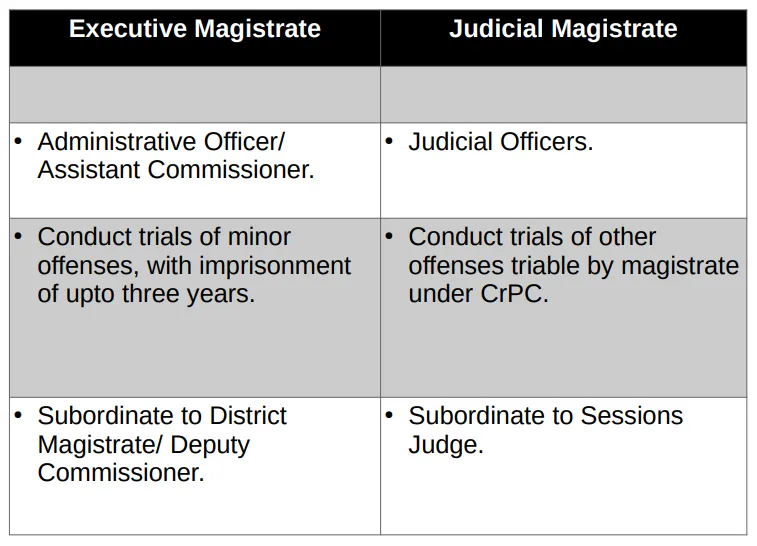Author: Muhammad Bin Sajid Adv.

Introduction
In Pakistan’s criminal justice system, two primary courts adjudicate criminal cases:
1. The Court of Sessions:
This court handles serious criminal matters such as murder trials and also decides applications for pre-arrest bail. It is superior to the court of the magistrates and is subordinate to the High Court.
2. The Court of Magistrates:
The magistrate’s court is the lowest tier in the criminal justice hierarchy. In Islamabad Capital Territory (ICT), two types of magistrates operate:
Judicial Magistrates:
They are the Judicial officers who conduct criminal trials within their prescribed jurisdiction. There are further four classes of judicial magistrates:
(1) Magistrates of the first class.
(2) Magistrates of the Second class.
(3) Magistrates of the third class.
(4) Special Judicial Magistrates
Executive Magistrates:
They are the administrative officers or assistant commissioners vested with certain magisterial powers. They adjudicate minor offences punishable with imprisonment of less than three years. There are further seven classes of executive magistrates:
(1) District Magistrates.
(2) Additional District Magistrates.
(3) Sub-divisional Magistrates.
(4) Special Executive Magistrates.
(5) First Class Magistrates.
(6) Second Class Magistrates.
(7) Third Class Magistrates.
Historical Background
1. Law Reforms Ordinance, 1972
The current legal framework of executive magistracy in Islamabad was introduced through the Law Reforms Ordinance, 1972 and Law Reforms Act, 1972 which amended the Code of Criminal Procedure, 1898 (Cr.P.C.). It established two distinct categories of magistrates:
Executive Magistrates
Judicial Magistrates
The Ordinance empowered Provincial Governments to confer additional powers to executive magistrates, specified in the Fourth Schedule to the Cr.P.C. (via Section 37), including:
Conducting summary trials
Recording confessions under Section 164 Cr.P.C.
Authorizing detention in police custody under Section 167 Cr.P.C.
Conducting identification parades
Taking cognizance of offences under Section 190 Cr.P.C.
Thus, parallel systems of executive and judicial magistracy were created to exercise judicial powers and conduct criminal trials.
2. Legal Reforms Act, 1997
The Legal Reforms Act, 1997 further amended the Cr.P.C., significantly enhancing the powers and jurisdiction of Executive Magistrates. Two key provisions were inserted:
Jurisdiction over specific PPC offences:
Executive Magistrates were empowered to try offences under Chapters VIII, X, XIII, and XIV of the Pakistan Penal Code (PPC), excluding Sections 153A and 281.Authority over other offences:
They were authorized to try offences other than in PPC, which are punishable with imprisonment not exceeding three years, with or without any additional penalty.
3. Code of Criminal Procedure (Amendment) Ordinance, 2001 (First Amendment)
This Ordinance repealed most provisions of the 1972 reforms related to executive magistracy, effectively abolishing the system of Executive Magistrates. It was a step toward implementing the constitutional mandate under Article 175(3), which requires a clear separation of the judiciary from the executive.
4. Code of Criminal Procedure (Amendment) Ordinance, 2001 (Second Amendment)
Soon after, a Second Amendment Ordinance was promulgated. Through Section 2, it modified the implementation clause of the First Amendment Ordinance by stating that:
“To the extent of Islamabad Capital Territory, the provisions of the 1st Amendment Ordinance shall come into force on such date as the Federal Government may, by notification in the official gazette, specify.”
However, no such notification has been issued to date, meaning the 1972 executive magistracy framework continues to operate in Islamabad, even though it has been repealed elsewhere in Pakistan.
5. The Luqman Zafar Case (W.P. No. 1838/2024)
On 31-07-2024, the Islamabad High Court delivered a landmark judgment in Luqman Zafar v. Federation of Pakistan, declaring the concept of executive magistracy in ICT as unconstitutional, being in conflict with Article 175(3) of the Constitution.
The court ordered that all judicial powers previously exercised by executive magistrates in Islamabad be withdrawn. However, the decision has been challenged via intra-court appeal, and the operation of the judgment is currently stayed pending the outcome of the appeal.
Current Powers and Functions of Executive Magistrates in Islamabad
Despite legal challenges, Executive Magistrates (typically Assistant Commissioners) in Islamabad currently exercise the following powers:
Conduct summary trials
Record confessions under Section 164 Cr.P.C.
Conduct identification parades
Authorize detention under Section 167 Cr.P.C.
Take cognizance of offences under Section 190 Cr.P.C.
Try offences under Chapters VIII, X, XIII, and XIV of the PPC, excluding Sections 153A and 281
Try offences, other than in PPC, punishable with imprisonment of up to three years
Powers and Functions of Judicial Magistrates in Islamabad
Judicial Magistrates in Islamabad are empowered to conduct trials of offences triable by a magistrate as per the eighth column of the Second Schedule of the Cr.P.C. However, they do not try offences that fall within the exclusive jurisdiction of Executive Magistrates, as outlined above.
Conclusion
The dual structure of magistracy in Islamabad reflects a legal anomaly. While the rest of Pakistan has moved towards a separation of the judiciary and executive following constitutional mandates and legislative amendments, Islamabad continues to follow an outdated model due to administrative inaction.
This situation undermines constitutional principles and creates inconsistency in the application of criminal law. The recent judgment in the Luqman Zafar case highlights the urgency for reform. The Federal Government must take immediate steps to:
Issue the notification required to enforce the First Amendment Ordinance in ICT.
End the judicial role of executive officers, in line with Article 175(3).
Ensure that all judicial powers are exercised exclusively by independent judicial magistrates, thus restoring public confidence in the rule of law and judicial impartiality.

Good web site! I really love how it is simple on my eyes and the data are well written. I’m wondering how I could be notified when a new post has been made. I have subscribed to your feed which must do the trick! Have a nice day!